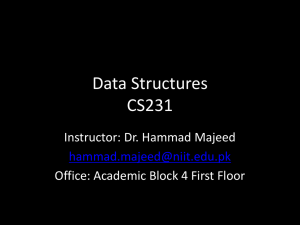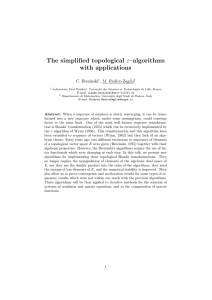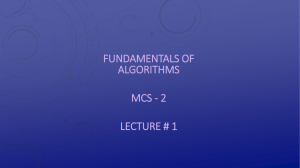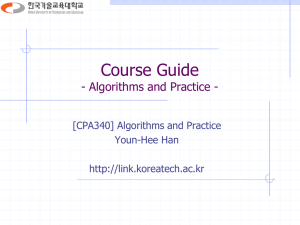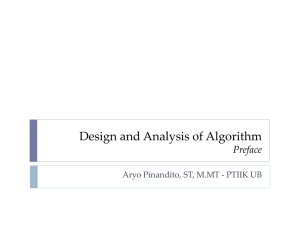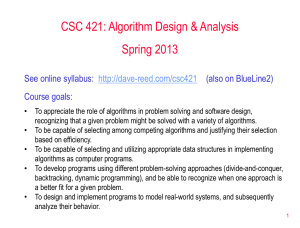Chapter 0: Introduction
advertisement
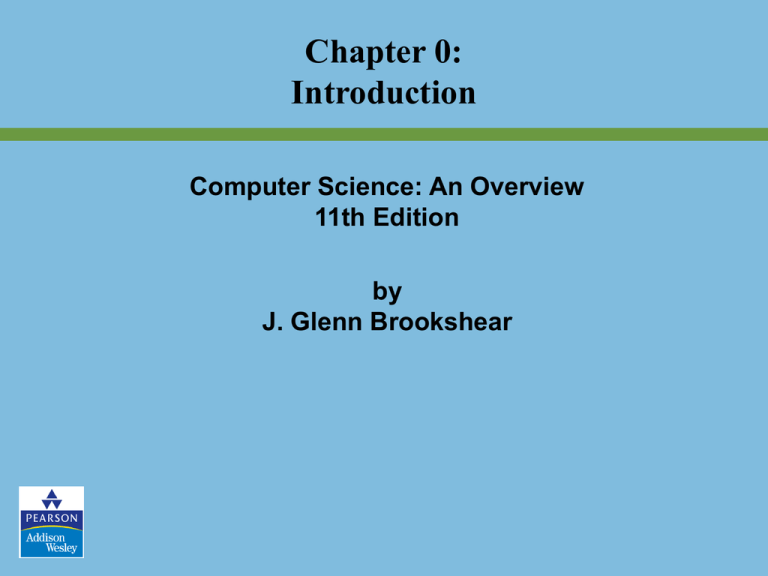
Chapter 0: Introduction Computer Science: An Overview 11th Edition by J. Glenn Brookshear Chapter 0: Introduction • • • • • • 0.1 The Role of Algorithms 0.2 The Origins of Computing Machines 0.3 The Science of Algorithms 0.4 Abstraction 0.5 An Outline of Our Study 0.6 Social Repercussions 0-2 Terminology • Algorithm: A set of steps that defines how a task is performed • Program: A representation of an algorithm • Programming: The process of developing a program • Software: Programs and algorithms • Hardware: Equipment 0-3 Figure 0.1 An algorithm for a magic trick 0-4 History of Algorithms • The study of algorithms was originally a subject in mathematics. • Early examples of algorithms – Long division algorithm – Euclidean Algorithm • Gödel's Incompleteness Theorem: Some problems cannot be solved by algorithms. 0-5 Figure 0.2 The Euclidean algorithm 0-6 Origins of Computing Machines • Early computing devices – Abacus: positions of beads represent numbers – Gear-based machines (1600s-1800s) • Positions of gears represent numbers • Blaise Pascal, Wilhelm Leibniz, Charles Babbage 0-7 Figure 0.3 An Abacus 0-8 Early Data Storage • Punched cards – First used in Jacquard Loom (1801) to store patterns for weaving cloth – Storage of programs in Babbage’s Analytical Engine – Popular through the 1970’s • Gear positions 0-9 Early Computers • Based on mechanical relays – 1940: Stibitz at Bell Laboratories – 1944: Mark I: Howard Aiken and IBM at Harvard • Based on vacuum tubes – 1937-1941: Atanasoff-Berry at Iowa State – 1940s: Colossus: secret German code-breaker – 1940s: ENIAC: Mauchly & Eckert at U. of Penn. 0-10 Figure 0.4 The Mark I computer 0-11 Personal Computers – First used by hobbyists – IBM introduced the PC in 1981. • Accepted by business • Became the standard hardware design for most desktop computers • Most PCs use software from Microsoft 0-12 Computer Science • The science of algorithms • Draws from other subjects, including – Mathematics – Engineering – Psychology – Business Administration 0-13 Central Questions of Computer Science • Which problems can be solved by algorithmic processes? • How can algorithm discovery be made easier? • How can techniques of representing and communicating algorithms be improved? • How can characteristics of different algorithms be analyzed and compared? 0-14 Central Questions of Computer Science (continued) • How can algorithms be used to manipulate information? • How can algorithms be applied to produce intelligent behavior? • How does the application of algorithms affect society? 0-15 Figure 0.5 The central role of algorithms in computer science 0-16 Abstraction • Abstraction: The distinction between the external properties of an entity and the details of the entity’s internal composition • Abstract tool: A “component” that can be used without concern for the component’s internal properties 0-17 Outline of Our Study • • • • • • Chapter 1: Chapter 2: Chapter 3: Chapter 4: Chapter 5: Chapter 6: Data Storage Data Manipulation Operating Systems Networks and the Internet Algorithms Programming Languages 0-18 Outline of Our Study (continued) • • • • • • Chapter 7: Software Engineering Chapter 8: Data Abstractions Chapter 9: Database Systems Chapter 10: Computer Graphics Chapter 11: Artificial Intelligence Chapter 12: Theory of Computation 0-19




